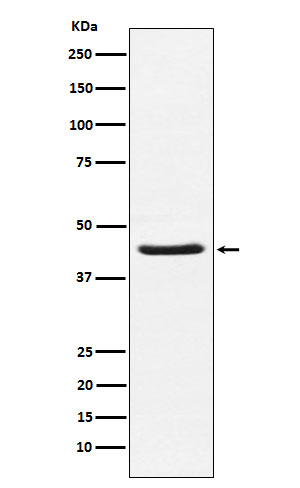HSD3B1 Antibody
Rabbit mAb
- 产品详情
- 实验流程
Application
| WB, IF, ICC |
|---|---|
| Primary Accession | P14060 |
| Reactivity | Human |
| Clonality | Monoclonal |
| Other Names | 3-beta-HSD I; 3BETAHSD; 3BH; 3BHSD; HSD3B; HSD3B1; HSDB3; HSDB3A; SDR11E1; |
| Isotype | Rabbit IgG |
| Host | Rabbit |
| Calculated MW | 42252 Da |
| Dilution | WB 1:500~1:2000 ICC/IF 1:50~1:200 |
|---|---|
| Purification | Affinity-chromatography |
| Immunogen | A synthesized peptide derived from human HSD3B1 |
| Description | 3-beta-HSD is a bifunctional enzyme, that catalyzes the oxidative conversion of Delta(5)-ene-3-beta-hydroxy steroid, and the oxidative conversion of ketosteroids. |
| Storage Condition and Buffer | Rabbit IgG in phosphate buffered saline , pH 7.4, 150mM NaCl, 0.02% sodium azide and 50% glycerol. Store at +4°C short term. Store at -20°C long term. Avoid freeze / thaw cycle. |
| Name | HSD3B1 (HGNC:5217) |
|---|---|
| Synonyms | 3BH, HSDB3A |
| Function | A bifunctional enzyme responsible for the oxidation and isomerization of 3beta-hydroxy-Delta(5)-steroid precursors to 3-oxo- Delta(4)-steroids, an essential step in steroid hormone biosynthesis. Specifically catalyzes the conversion of pregnenolone to progesterone, 17alpha-hydroxypregnenolone to 17alpha-hydroxyprogesterone, dehydroepiandrosterone (DHEA) to 4-androstenedione, and androstenediol to testosterone. Additionally, catalyzes the interconversion between 3beta-hydroxy and 3-oxo-5alpha-androstane steroids controlling the bioavalability of the active forms. Specifically converts dihydrotestosterone to its inactive form 5alpha-androstanediol, that does not bind androgen receptor/AR. Also converts androstanedione, a precursor of testosterone and estrone, to epiandrosterone (PubMed:1401999, PubMed:2139411). Expected to use NAD(+) as preferred electron donor for the 3beta-hydroxy-steroid dehydrogenase activity and NADPH for the 3-ketosteroid reductase activity (Probable). |
| Cellular Location | Endoplasmic reticulum membrane; Single-pass membrane protein. Mitochondrion membrane; Single-pass membrane protein |
| Tissue Location | Placenta and skin (PubMed:1401999). Predominantly expressed in mammary gland tissue. |
Research Areas
For Research Use Only. Not For Use In Diagnostic Procedures.
Application Protocols
Provided below are standard protocols that you may find useful for product applications.
终于等到您。ABCEPTA(百远生物)抗体产品。
点击下方“我要评价 ”按钮提交您的反馈信息,您的反馈和评价是我们最宝贵的财富之一,
我们将在1-3个工作日内处理您的反馈信息。
如有疑问,联系:0512-88856768 tech-china@abcepta.com.
¥ 1,500.00
Cat# AP92625























 癌症的基本特征包括细胞增殖、血管生成、迁移、凋亡逃避机制和细胞永生等。找到癌症发生过程中这些通路的关键标记物和对应的抗体用于检测至关重要。
癌症的基本特征包括细胞增殖、血管生成、迁移、凋亡逃避机制和细胞永生等。找到癌症发生过程中这些通路的关键标记物和对应的抗体用于检测至关重要。 为您推荐一个泛素化位点预测神器——泛素化分析工具,可以为您的蛋白的泛素化位点作出预测和评分。
为您推荐一个泛素化位点预测神器——泛素化分析工具,可以为您的蛋白的泛素化位点作出预测和评分。 细胞自噬受体图形绘图工具为你的蛋白的细胞受体结合位点作出预测和评分,识别结合到自噬通路中的蛋白是非常重要的,便于让我们理解自噬在正常生理、病理过程中的作用,如发育、细胞分化、神经退化性疾病、压力条件下、感染和癌症。
细胞自噬受体图形绘图工具为你的蛋白的细胞受体结合位点作出预测和评分,识别结合到自噬通路中的蛋白是非常重要的,便于让我们理解自噬在正常生理、病理过程中的作用,如发育、细胞分化、神经退化性疾病、压力条件下、感染和癌症。






